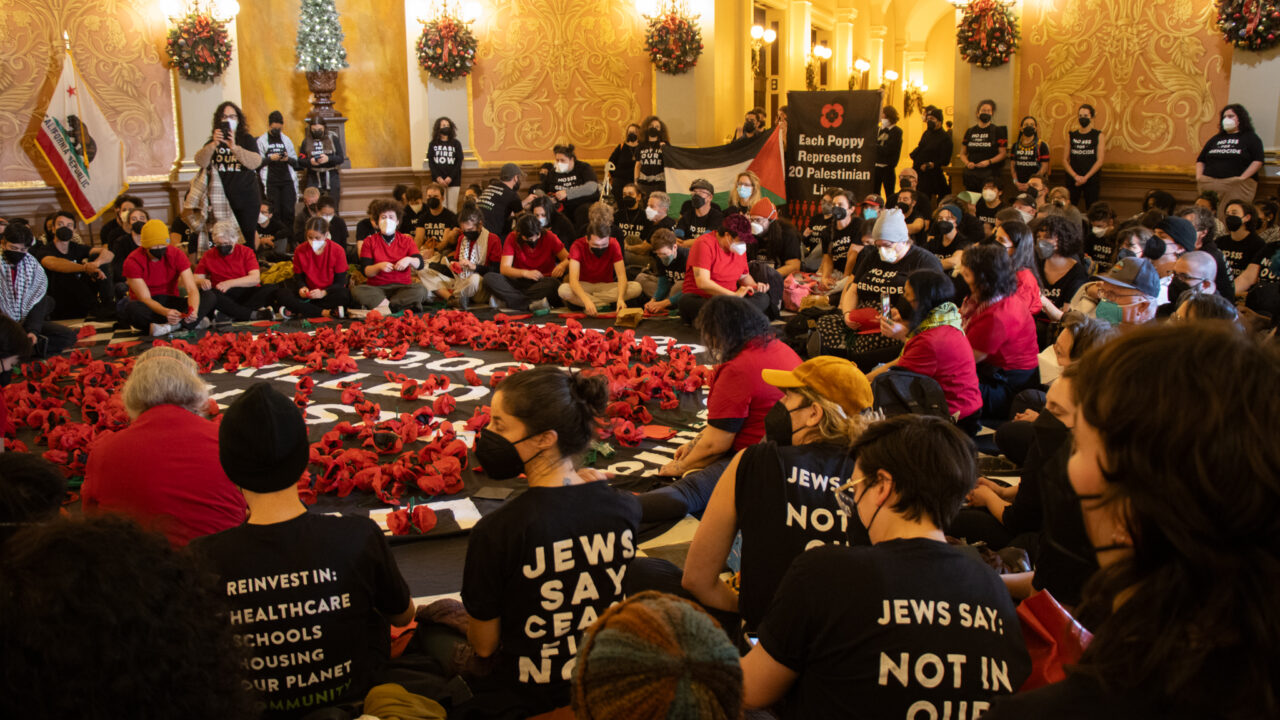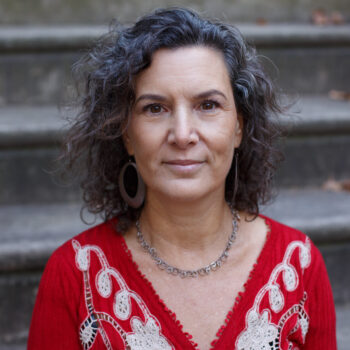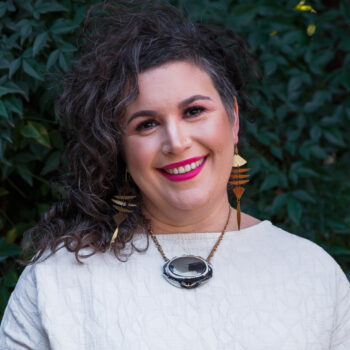Fourteen months into Israel’s U.S.-funded genocide against Palestinians, we face the daunting, painful conundrum of the movement in support of Palestinian freedom being bigger, stronger, and more determined than ever in history and simultaneously that the genocide is continuing unabated, expanding into attacks by Israel into Lebanon, Iran, Yemen, and the West Bank.
As staff leaders of Jewish Voice for Peace (JVP) from 2009-2019, we’ve thought a lot about the ebb and flow of organizing, the importance of building durable institutions if we want to wage governing power, and the tensions and possibilities of building movement institutions within a nonprofit framework. We pulled some of these lessons together in our recent book, Solidarity is the Political Version of Love: Lessons from Jewish Anti-Zionist Organizing (Haymarket, 2024). We finished the manuscript in September 2023, never imagining the devastation that would follow over the next year, or just how relevant the lessons from our early years would be for this moment.
It can be difficult, in a time of such catastrophic urgency, to think about the long-haul nature of organizing in general and in the struggle for Palestinian freedom in particular. But even now, or maybe especially now, we need to think about how to make sure we are absorbing all the new people who have come out to the streets in horror at Israel’s actions, and we need to make sure they have the resources, tools, and structures they need to stick with it when, inevitably, attention turns toward other crises (which we know will come fast and furious under Trump). That takes a commitment to long-term organizing and the infrastructure that enables it.
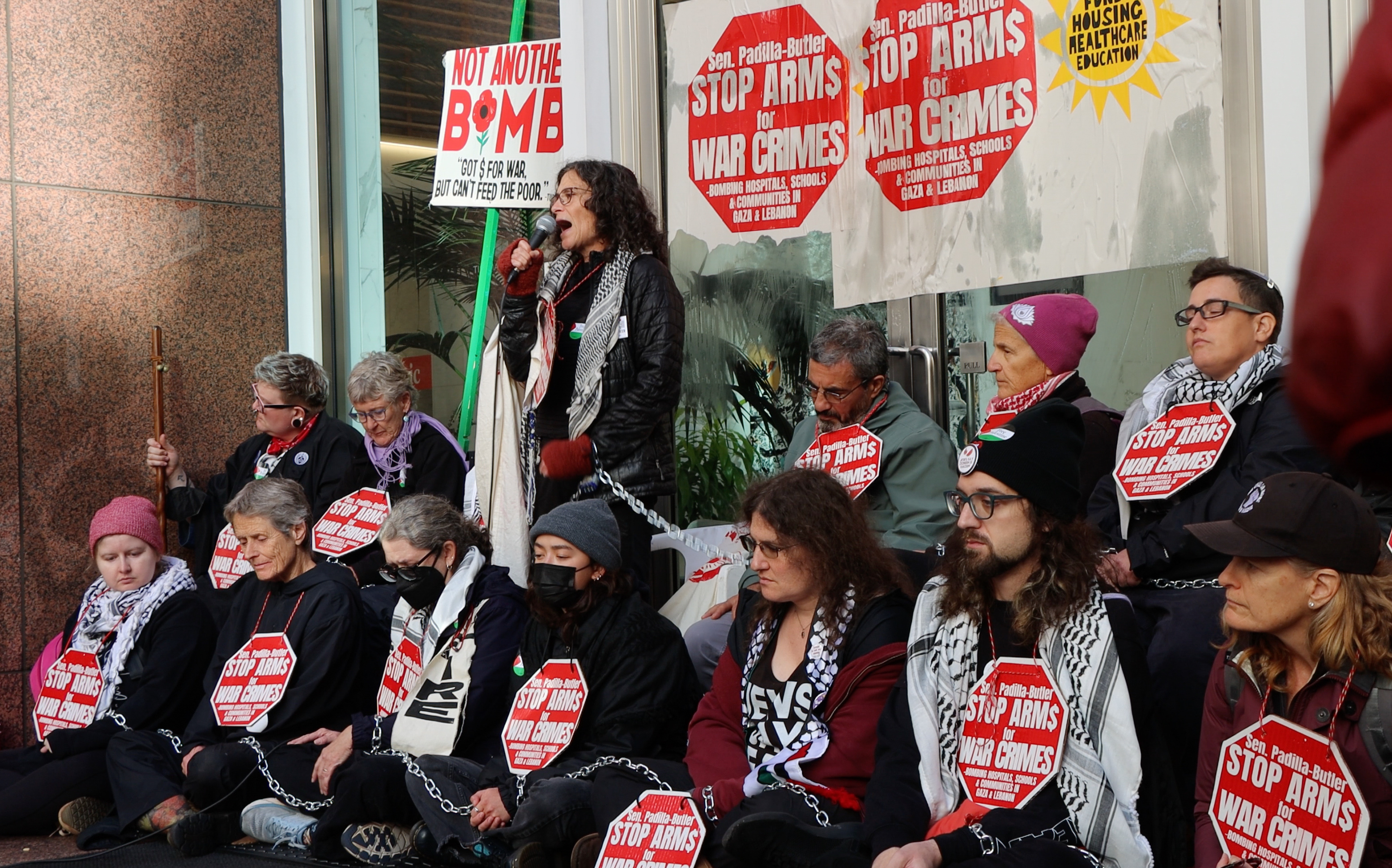
This moment is the most sustained and consequential moment of Palestine solidarity that anyone alive can remember, a moment of rupture. But in our decades of doing this organizing work, we remember the wars on Gaza and uprisings against the siege of 2009, 2012, 2014, 2018 and 2021. Each created moments of huge inflow of members into JVP, followed by moments of absorption and integration. Here we offer some lessons we learned from leading during those moments that may be applicable to this one.
Embracing Contradictions
One way we’re thinking about this moment is the way we found we thought about a lot of things during our time at JVP: embracing the both/and. That means holding contradictory ideas and realities together, knowing two things can be true at once: we were at once a movement and a workplace. We were rejected from Jewish communities we grew up in, but also through force of will made it possible to build new communities that match our values and vision for a Judaism beyond Zionism. We are organizing toward an end of forced exile for Palestinians even as we embrace diaspora for ourselves.
Both/and is a concept we used a lot in our organizing, analysis, and whenever we had to make hard decisions. It has helped us be expansive rather than binary about our thinking and work to reconcile seemingly disparate threads. In this moment, the both/and encompasses the urgency of the now with the need, even during this moment of crisis, to think about how to build and sustain the energy that has been built since last October.
JVP’s structure, with a strong national staff and a network of members and chapters, is a somewhat common arrangement for social justice organizations (a few similar examples include SURJ, Working Families Party, and 350.org). During our time at JVP, its internal structures and organizing model had an aspect of both/and. JVP has been, almost since its founding, both a movement organization and a nonprofit with a board, staff, and the governance and decision making hierarchies that entails as well as a robust membership organization and chapter network that informed its political trajectory. Within this model members are involved in setting national strategy and also autonomously developed campaigns, coalitions, and unique cultures locally, some of which were then adapted nationally. Concurrent with this internal structure, there is always the tension between rapid response and the long haul.
As a movement building organization our focus was on growing a massive base of members, donors, and supporters to build and deploy power as part of the broader Palestine solidarity movement within the legal confines of a nonprofit. As a nonprofit, issues of staffing, governance, fundraising, and the other core functions of a workplace ensured the movement building work could thrive. Of course, in this fraught political moment when 501c3 statuses of political organizations are under federal threat, there may need to be an involuntary innovation in forms of organization to come!
Building Political Home
We believe what has long made JVP’s communal spaces—whether in person or online—powerful and meaningful beyond the constant stream of campaigns and projects is that they allow people to express their whole selves, in all their complexity, often for the first time. This sense of belonging—a core human need that many people find at synagogue, church, mosque, ethnic heritage associations, block associations, labor unions, and more—is part of what makes JVP an enduring political home for so many and is the “secret sauce” that keeps movements vibrant when the emotional labor of the political work is daunting.
Whatever movement you may be part of, building a political home as part of a hard-hitting political movement can produce profound rewards: Rewards for each person who is a part of the political home and who reaps the emotional benefits. Rewards to the organization and broader movement as deeply invested and connected circles of members assure the sustainability of the organization for the long haul. Rewards for future generations, as through the work of building political homes we ensure the evolution of our cultural and religious traditions as an enduring force for justice.
Henry Gates Jr reflected on the power of the Black Church in playing this role––central to the wins of the civil rights movement:
“The Black Church, in a society in which the color line was strictly policed, amounted to a world within a world, providing practical physical and social outlets and economic resources for local African American communities. Even in the antebellum period, the Black Church was the proving ground for the nourishment and training of a class of leaders; it fostered community bonds and established the first local, regional, and then national Black social networks.”
As we are touring with the book and getting the precious opportunity to be in person with community and campus anti-Zionist organizers across the country, we are hearing how much pain people are in. For Palestinians, it is the unbearable pain of watching as their families, communities, and people are being systematically destroyed as the world watches. Jewish activists, though the pain cannot be compared, are struggling with their families, social circles, and Jewish institutions who are supporting this genocide. American Jewish communities are rupturing, and while that rupture is welcome and necessary, it is also incredibly painful. It is our job to end to that pain lest organizers and leaders and would-be members slink back from movement work in despair and heartbreak.
One of the gifts organizing offers is the chance to not just change oppressive conditions and policies today, to dream up and organize toward a different future, but also the chance to be in relationship with our ancestors. In any movement work, creating space for members or participants in your organizing community to connect to the histories and traditions of their people can provide inspiration and deeper meaning in how you frame your demands and design your actions. This can involve pulling from the cadence in liturgical traditions, the rituals of the holidays, the reinterpretation of sacred texts, or calling back to communal memories, commemorations, or victories.
In October, a constellation of Jewish organizations (JVP, If Not Now, Jews for Racial and Economic Justice, Congregation Kolot Chayeinu) led by Rabbis for Ceasefire organized a mass outdoor Yizkor (remembrance) ritual on Yom Kippur afternoon when it is traditionally recited in synagogue. Over a thousand people gathered in person with over 6000 watching via livestream. We gathered to remember and grieve and honor the dead and reaffirm our commitment to life. Rabbis guided the traditional prayers of remembrance woven within the constant reminder that today we understand that “every life is a universe.”
Muslim community members, including city councilmember Shanana Hanif, and dozens of members of Christians for a Free Palestine offered essential logistical support for the action so Jews could attend this ritual as part of their Yom Kippur observance. Throughout modern history, multifaith solidarity has allowed many people, including Jews, to survive fascism and other forms of oppression. This allowed us the space and time to truly mourn in the ways that we need to continue the fight.
This Yizkor ritual embodied our commitment to being tethered to our ancestors, rooted in our present political obligations, all while building the world we want our children to inherit.
Binding the present and future to the past can develop organizing that heals and motivates. The traditions passed down to us—whoever the “us” may be—are the building blocks of rooted and visionary political action.
From Mobilizing to Campaigning
The past year has seen unprecedented street protests in support for Palestinian rights. The steady stream of building occupations, student encampments, and mass marches are encouraging evidence of a revitalized Left. As organizers, our work now is to translate this energy into concrete wins by mounting campaigns targeting local institutions. This will ensure that we are continuously developing leaders, inviting people to build new skills, and cultivating community to keep feelings of ostracization and rejection at bay.
After a year of non-stop creative discipline actions to stop it, it’s almost impossible not to be demoralized by the ongoing genocide. As we head into year two of this horror, we need to build off of impactful one-off direct actions designed to garner social media and press attention to carefully researched and structured campaigns directed at specific targets that will yield tangible refusal of the US blank check for Israel and that safeguard against the erosion of our civil liberties.
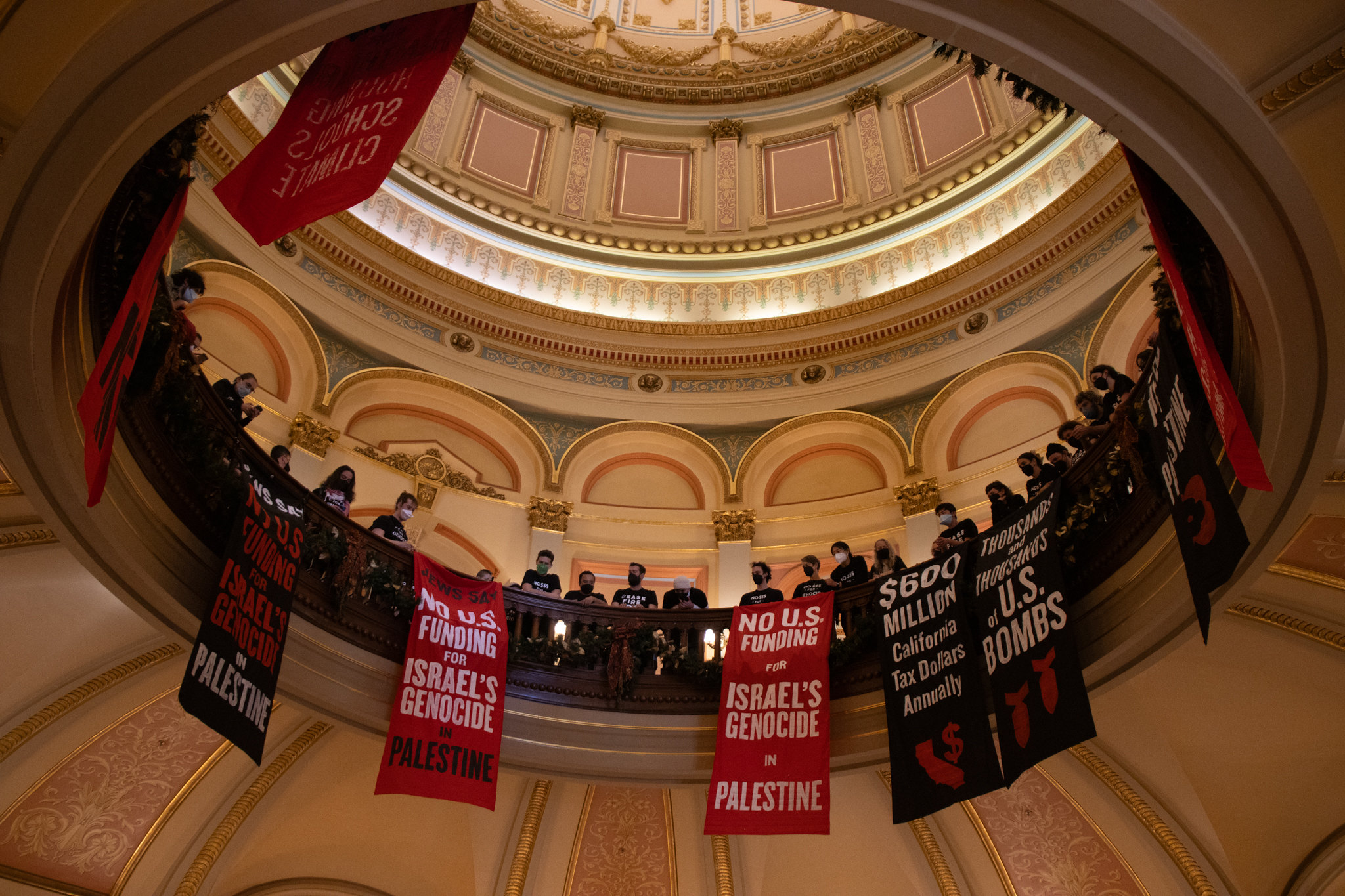
At their sharpest, campaigns can change the current reality, develop leadership of members, empower and mobilize a base’s energy, bring new people into movement, create a platform for political education, and bolster infrastructure for long term organizational stability. In the coming months we hope to seeWe hope to see in the coming months a proliferation of campaigns that funnel energy from actions that echo disciplined calls for an arms embargo to sophisticated campaign structures.
Over the past year, impressive new coalitions have been established on local and national levels. Campaigns are emerging now to maintain these movement partnerships and relationships and build their power. Whether in divestment campaigns targeting student governments taken up on campus, passing ceasefire or arms embargo resolutions in city councils, or national efforts to divest from Israeli bonds or support bills or resolutions by progressive legislators, coalitions that commit together to campaigns can shore up their relationships and durability.
Capitalizing on the unique constituency an organization brings to the table when creating or joining campaigns maximizes the value added it offers and builds power. For example the Deadly Exchange campaign, which ran from 2017-2022, was a specific contribution that JVP could launch as U.S. Jews. It succeeded not only in educating the wider public that the Anti-Defamation League (ADL) is less a civil rights institution than a pro-Israel right-wing advocacy organization, but culminated in the ADL ending its police exchange program with Israel. That campaign served as a powerful on-ramp for those new to the Palestinian freedom movement, built transferable organizing skills among member leaders, and provided ways to tangibly ensure the conversation about Palestine was ongoing and part of abolitionist organizing and building and utilizing strong cross-movement coalitions.
No matter the activity—building chapters, engaging the media, designing campaigns, engaging different constituencies—it is all actually part of the same goal: building a membership broad and deep enough to influence the narrative, reality, and eventually U.S. laws and policies or even the transformation of entire systems of oppression.
Growing our Base While Sharpening our Politics
At several moments in JVP’s history, a choice had to be made about whether to extend ourselves to take a political position that was on the leading edge of what the Jewish community could tolerate. The decision to become an anti-Zionist organization, is an example of how patient, thorough internal processes can serve political ends. It also serves as a reminder that not only people but the organizations that serve them must push themselves to continue to evolve.
By 2015, when JVP’s internal discussion of Zionism was gearing up, it had become large enough to have a number of constituencies who brought different concerns and represented different positionalities from within Jewish communities. To take the two most obvious poles: students who are just in the process of beginning their lives and the paths they will pursue have very different factors to consider than rabbis who, by definition, are embedded in a number of Jewish communal institutions and have congregations, pastoral relationships, professional associations, and jobs to consider. With JVP’s decision to take an organizational position on Zionism came the realization of the need to move slowly enough to have time to consider the decision not only as a political strategy but also as a position that would affect members’ lives.
We recall being acutely aware of the responsibility, both in the Jewish world and to our Palestinian allies and others, to help shift the debate in Jewish communities and beyond, including by helping to legitimize anti-Zionism which has been systemically vilified and equated with antisemitism. We knew, as the largest grassroots Jewish membership organization working in solidarity with Palestinians, that our positioning would have the power to accomplish this shift.
JVP leadership formed a committee through an application process that included board, staff, and members and was designed to represent the breadth of JVP members’ positions. Over two years, that committee planned an organization-wide curriculum in which more than seven hundred members participated across seven sessions, which also included opportunities for written reflection and chapter conversations between the sessions about how JVP’s approach to Zionism impacted JVP nationally and locally. An online zine collected member testimonies about their encounters and histories with Zionism. The process also included a survey of individual members; discussions at the 2017 National Membership Meeting; chapters submitting notes of their internal discussions; conversations with invited constituencies who had particular concerns, including rabbis, artists, students, and members focused on work in Congress; and feedback gathered in various forums and methods from JVP staff, the Jews of Color, Mizrachi and Sephardi Caucus, members of our advisory council, and Palestinian allies.
Ensuring that members––no matter their temperament or comfort––could participate and that multiple attempts were made to get genuine feedback and encourage participation, facilitated members’ embrace of the result. JVP lost very few members when we went public with a statement endorsing anti-Zionism at the end of this process, and in fact continued to attract new ones. It turned out to be a liberatory moment, one that Palestinians appreciated for offering them some cover (while perhaps wondering what had taken us so long!). As time went on and anti-Zionism became more and more targeted by right-wing forces as antisemitic—in response to the power of the Palestine solidarity movement; in particular, as a way to delegitimize Palestinian lived experience—JVP’s ability to act as an effective ally and partner was enhanced by this decision.
Members needed to go on this journey together, to hear each other’s strategic thinking and emotional considerations. They needed to share their fears. They needed to deepen their analysis and understanding of Zionism and of the importance to our Palestinian partners in boldly and clearly challenging it. JVP’s readiness to step out as anti-Zionist signaled a sense of strength and power to ourselves and to onlookers. It was about getting bigger and bolder and forcing wider American Jewish communities to follow the conversation where JVP wanted to take it, and ensuring the base of supporters was prepared for the fights and challenges that would inevitably ensue.
Committing to long-term movement building
Our movements require long-term, sustained efforts to build enough grassroots power to challenge the power of capitalism, racism, and imperialism that is arrayed against us. To seriously challenge and eventually win against these forces requires not just mobilizing and organizing but organization and infrastructure. It is not the sexiest of topics. But it is critical, if we are to meet the long term crises of our time, that we ensure there are strong containers to hold our organizing that transcend the news cycle and endure over time.
We can look back to the ways the Black Panthers provided free breakfast for kids at school as part and parcel of building political power toward liberation for Black people. In our time, The Arab Resource and Organizing Center (AROC) in the San Francisco Bay Area utilizes a multi-pronged strategy that is resonant with the Black Panthers model. AROC provides a centralized space for social services, meeting material needs of their community while also being clear and taking action based on their anti-Zionist politics.
There is no one model for successful long-term organizing, but this is a time to be creative and disciplined about being sure to be attentive to the long-term even when the immediate is overwhelming. When there are ongoing opportunities for absorbing new members, developing a leadership pipeline, running campaigns that challenge dominant narratives and win material gains it can create a sense of community as a bulwark against grief and fear. That creates space for individuals to challenge themselves to build new skills and stretch their thinking while contributing to and being part of a collective. All organizations and movements need to be flexible and evolve or they become hidebound and hoary.
There is no way to sugarcoat the challenges ahead of us or offer a quick fix. Our hope is that the Left will re-invest in the time-honored craft of organizing which has proven again and again to accomplish what at the start always felt impossible.
—
Rebecca Vilkomerson and Rabbi Alissa Wise were both staff leaders of Jewish Voice for Peace (JVP) from 2010-2020. They are the co-authors of Solidarity is the Political Version of Love: Lessons from Jewish Anti-Zionist Organizing (Haymarket, 2024). They continue to work for Palestinian liberation through Rebecca’s work with Funding Freedom and active membership in JVP-NYC, and Alissa’s with Rabbis for Ceasefire and membership in JVP-Philly.
